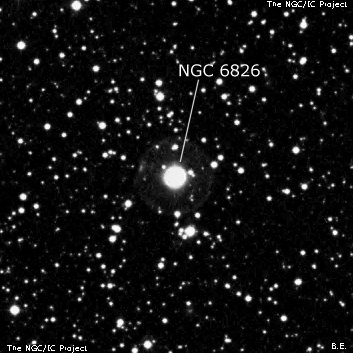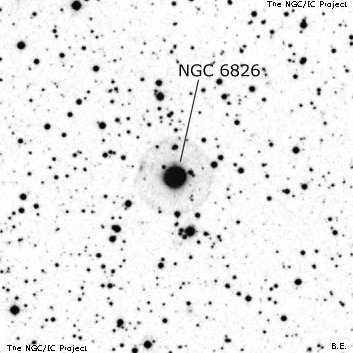NGC/IC Project Restoration Effort
(This is a very very beta version)
NGC6826


Basic Information
Location and Magnitude
Right Ascension: 19:44:48.2
Declination: +50:31:32
Constellation: CYG
Visual Magnitude: 8.8
Historic Information
Discoverer: Herschel W.
Year of discovery: 1793
Discovery aperture: 18.7
Observational
Summary description: planetary, B, pL, R, * 11 M
Sub-type: PN
Steve's Notes
=====
NGC 6826
48" (10/27/16): at 610x and 813x; both internal FLIERS (see observation below) were visible on the NW and SE sides of the central disc. The disc has a slight bulge on the northwest and southeast ends creating a slightly elongated, irregular oval NW-SE. A fainter inner halo was visible at 610x, roughly doubling the size. At 244x and NPB filter, a third large outer shell was fairly prominent forming a well defined 2' circular halo.
24" (9/13/12): at 325x the main 30" disc appeared slightly brighter in the east-southeast region. Adding an H-beta filter, a very small knot was sometimes visible near the rim at the east edge. This difficult knot is prominent on the HST image as a red FLIER (Fast Low-Ionization Emission Region). The corresponding knot on the west edge was not visible. The red color of these FLIERS is from ionized nitrogen and it disappeared switching to an OIII filter, although the large outer halo became visible.
24" (8/16/12): at 300x and an OIII or NPB filter, the main high surface brightness disc (slightly elongated) is surrounded by a very faint, fairly uniform giant halo, extending 2' diameter and quadrupling the size of the bright 30" disc! The outer halo seemed perfectly round with a well-defined edge and was easily visible.
18" (7/17/07): at 500x the "Blinking" Planetary is slightly elongated ~E-W, ~30"x25" with a bright 10th mag central star surrounded by a small, slightly darker annulus. The disc is pretty evenly lit but slightly weaker on the west or west-southwest side.
17.5" (8/17/01): beautiful view at 500x; the disc is slightly elongated WNW-ESE, with subtle structure. There is small, slightly darker region around the bright 10th magnitude central star. The halo appears to dim slightly along the preceding edge and this edge is not as sharply defined. Located 28' E of the double star 16 Cygni.
17.5": very bright 25" roundish nebula surrounding a bright 10th magnitude central star, slightly elongated ~E-W, high surface brightness. With direct vision the planetary appears brighter on the south side. The planetary is too bright with this aperture to have the striking "blinking" effect seen with smaller apertures.
8": the famous "blinking" planetary blinks well with this aperture. Contains a bright mag 10 central star (HD 186924) visible with direct vision and the outer nebulosity dominates with averted vision.



